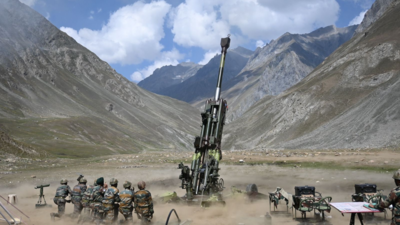
NEW DELHI: After forward deploying howitzers, missiles, rocket systems and loiter munitions along the China frontier, India is now stepping up induction of more long-range, high-volume precision firepower that can prove decisive in battles as well as expanding its indigenous ammunition vendor base to counter global supply chain disruptions.
With lessons being learnt from the ongoing Russia-Ukraine war, in which 80% of the casualties have been due to artillery fire, Army’s director general of artillery Lt-General Adosh Kumar said the force will induct 100 more K-9 Vajra self-propelled tracked gun systems, as also additional Dhanush howitzers, Sharang guns and Pinaka multi-launch rocket systems.
Some `winterised’ K-9 Vajra regiments are already deployed in eastern Ladakh, out of the 100 such guns inducted earlier for Rs 4,366 crore, amid the continuing military confrontation with China, which is into its fifth year now.
The around Rs 8,500 crore contract for 307 new indigenous advanced towed artillery gun systems (ATAGS), which have a strike range up to 48-km, is also set to be inked soon. Moreover, trials will begin next year for the planned induction of 300 `shoot-and-scoot’ mounted gun systems and 400 `versatile’ towed artillery gun systems.
DRDO is also working to enhance the range, accuracy and lethality of the conventional Pralay ballistic missiles (400-km range) and Nirbhay cruise missiles (1,000-km). Concurrently, DRDO is developing hypersonic missiles, which will be different from the already inducted 450-km range BrahMos supersonic cruise missiles.
“With its accurate and destructive firepower, artillery today represents the true essence of military power in dominating the battlefield. We are modernising at a pace like never before. Our mantra is ‘modernisation through indigenisation’,” Lt-Gen Kumar said.
Long-range vectors in the shape of indigenous Pinaka rocket systems, for instance, have added “more punch and lethality” to the arsenal. The Army will induct six more Pinaka regiments to add to the existing four, even as the strike range of the rockets is now being extended from the original 38-km to 75-km, with the high-altitude trials already over.
“The Pinaka is one of the best rocket systems in the world and is being exploited extensively. Our aim is to first double the range, and then quadruple it. We are looking at 120-km, 300-km ranges,” he said.
In the arena of loiter munitions, a ‘Make-II’ category project (prototype development funded by the industry) has evoked a “very good response” from private companies and start-ups. “Our aim is loiter munitions with 40-100-km range to engage targets in operational depth of an adversary,” he said.
A “lot of emphasis” is also being placed on indigenous production of different kinds of ammunition, with diversification of the vendor base. “We were earlier dependent on only one production agency for 155mm artillery ammunition. Now, production of all types of 155mm ammunition has been thrown open to the public and private sector,” Lt-Gen Kumar said.
The Army will conduct trials of different types of ammunition by various public and private sector companies in Oct-Nov. The force is also looking for induction of futuristic ammunition, which includes “area denial munitions” as well as the 1.15 lakh “nub-less artillery projectiles” already approved by the defence ministry. “A number of projects have also been initiated to increase our capability in precision-guided and terminally guided ammunition,” he said.
